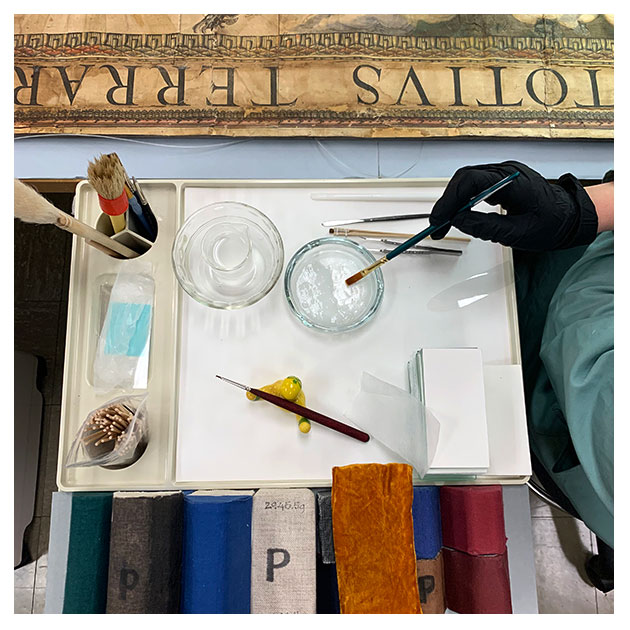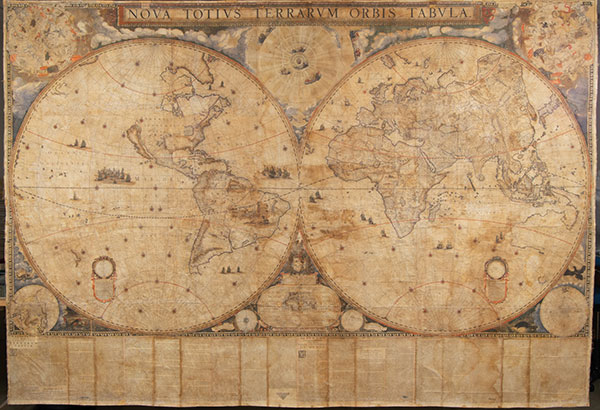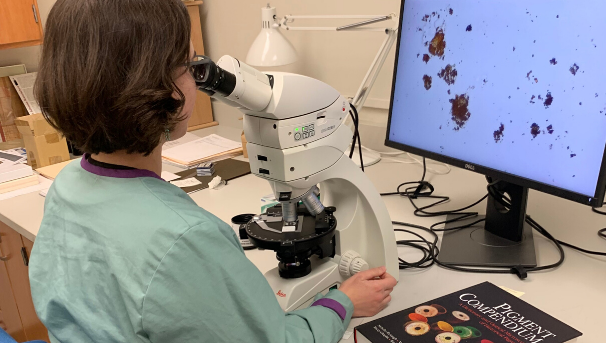
A one-of-a-kind 17th-century map housed at the Ransom Center for decades, currently too fragile to display, is now the subject of an intensive research and conservation project that will utilize scientific analysis to reveal the hidden story behind the map’s production and significance.
Created by celebrated Dutch cartographer Joan Blaeu in 1648, the 10′ x 7′ map titled Nova totius terrarum orbis tabula, is commonly known as the Blaeu World Map. This grand map is composed of 21 hand-printed engraved images that show the known geography of the Earth at that time along with images of the zodiac constellations and diagrams of the solar system. The image has been embellished with hand-applied watercolors and silk ribbon trim. There is also a ten-sheet letterpress-printed informative text along the bottom edge of the map that describes the nature of various landforms, climates around the globe, and navigational information. The map is lined with what is probably the original fabric.

Kress Paper Conservation Fellow Emily Farek and a collaborative group of conservation specialists are employing specialized techniques to conserve and stabilize this extraordinary artifact. In addition to analyzing the map and treating it for long-term preservation, the Blaeu Map project team plans to present the map and new information during a future exhibition at the Center.
“We can identify the pigments, binders, adhesives, and fibers that were used to create the map as we see it today,” Farek said. “This research not only helps us interpret the map and understand how it was made, but also anticipate the way its materials may degrade over time.”

For pigment and fiber identification, for example, Farek uses a technique called polarized light microscopy (PLM) to characterize the mineral makeup of pigments in a paint sample, as well as the fiber content of the paper and fabrics used to create the map, since each mineral and fiber behaves differently when exposed to polarized and cross-polarized light.
Through a collaboration with the Geosciences Department at the University of Texas, at Austin, painted areas of the map were recently analyzed using X-ray fluorescence spectroscopy (XRF). This technique determines the elemental composition of these areas, and used together with PLM, can help identify the pigments on the map, providing information about dating as well as possible degradation processes that can be mitigated.

The Blaeu project team can learn about the binders used in the paint as well. “Oil paint has an oil as a binder and watercolor has gum arabic as the binder,” Farek said. “We think a more dilute wash of color was used for the hand-coloring of the Blaeu Map, like with watercolor, and will use Fourier transform infrared spectroscopy (FTIR) to try and determine this.” FTIR can also help identify what adhesives were used in the creation of the map.
Soon, the team will work with the College of Natural Sciences to use high-performance liquid chromatography (HPLC) on samples of suspected organic pigments. HPLC can help determine the presence of these pigments, which cannot be characterized using XRF.
The extensive research undertaken by the Blaeu Map project team will be used to connect all aspects of the map’s context, shed light on its method of manufacture, and illustrate why it is important as an historic record of cartography, papermaking, printmaking, and artistic materials. In consultation with map scholars, researchers, and curators, this material knowledge will be paired with research on the history of cartography and the social and economic significance of a wall map of this size.
The Blaeu World Map, already striking to look at on the surface, has even more to offer the viewer through a deeper understanding of the map’s hand-coloring, constellations, landforms, diagrams, layered structure, and more. Hidden aspects of the map will be uncovered and revealed during this project.
The next journey of this extraordinary 17th-century world map housed at the Harry Ransom Center in Austin, Texas, is underway. Members, donors, and visitors are helping set the course of this amazing project as conservators preserve the one-of-a-kind map, revealing new discoveries about its production and significance. Learn more at https://40for40.utexas.edu/giving-day/19787/department/29215.
